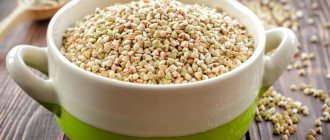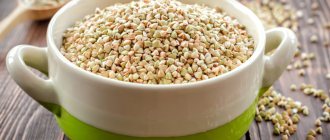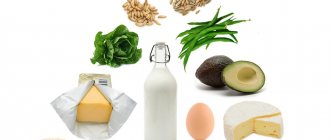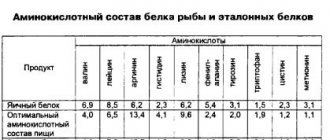The benefits of buckwheat for an athlete
The rich natural composition of buckwheat - complex carbohydrates, a complex of vitamins, minerals, excellent taste - make it popular for a healthy diet. For those who play sports, porridge made from this cereal is one of the main elements of the diet. What are the benefits of consuming it and why is it so important for the body?
- Reduces the concentration of cholesterol in the blood;
- improves appetite;
- accelerates metabolism, promotes smooth functioning of the gastrointestinal tract;
- promotes overall strengthening of the body due to a complex of useful substances;
- normalizes blood pressure and heart function;
- stimulates the burning of fat reserves;
- is a source of protein with essential amino acids, which is so important for bodybuilding;
- increases the period of saturation;
- reduces blood glucose levels;
- removes excess water from the body;
- promotes muscle growth;
- increases physical endurance;
- contains antioxidants that remove harmful substances and slow down the aging process.
It should be noted that buckwheat is an environmentally friendly product: when growing it there is no need to use pesticides, it grows well anyway.
The absence of gluten in the composition makes buckwheat one of the important components of diets, including sports ones. The main thing is to know when - before or after physical activity - to properly consume the product, as well as the correct methods of preparing it for those who are engaged in bodybuilding.
Raw food football player Dan Howell
Dan Howell - 31 years old, professional footballer, has played for many clubs, most recently playing for Crawley FC (USA) in League 2.
From his personal experience and self-education in the health field, illness and injury are associated with poor nutrition. His injury problems were a key factor in switching to a different diet - a raw food diet.
Dan Howell: “My diet is actually quite simple. I eat alkaline foods. Alkaline foods are foods provided by nature, such as herbs, fruits, vegetables and natural grains. I learned about the importance of pH. pH ranges from 0-14 with 7 being neutral. Any food or drink with a pH above 7 is alkaline, below 7 is acidic. Acidic foods affect the health of people who regularly consume them. When I realized that meat and dairy products were the most acidic foods, I immediately removed them from my diet. The results were almost immediate. My speed, energy, flexibility, endurance and recovery improved and I gained additional strength, which prevented bone and joint injuries.”
What foods keep Dan Howell at an optimal level of fitness and speedy recovery?
Protein: “The most frequently asked question for me is how and where do I get protein for my body. This answer is quite simple, eating plants. We are a living organism that requires oxygen, water, sunlight and minerals to survive. Plant protein contains all the essential amino acids that the body recognizes and absorbs in perfect synchronization with our biological chemistry. Plant proteins contain 8 amino acids; our body requires them, but, naturally, does not produce them. Hemp, chlorella, spirulina and quinoa are my sources of plant protein. I eat quinoa as a replacement for acid-producing grains: wheat, barley, corn and rice. I completely avoid soy products. Research in 2010 showed that 93% of soybeans are genetically modified and contain pesticides. In comparison, hemp is much better and has more digestible protein.”
Energy: “Every plant I eat is a carbon-hydrogen-oxygen base that gives me amazing energy. Herbs with high iron content are vital, oxygen supply to the blood is important for my physical fitness. Iron is essential for brain function. This is very important in my profession, I have to be sharp and make quick decisions. I avoid all foods and drinks with sugar, and choose plant-based sweeteners, which have an alkalizing effect on the body. I especially like the raw drink of raw cacao and agave maca.”
Dan Howell, in addition to quinoa, hemp seeds, spirulina, chlorella, consumes quinoa, green buckwheat, fruits, and vegetables.
Many raw food bodybuilders are wary of GMO products, so they use hemp and buckwheat sprouts as a source of protein.
Buckwheat before training
Physical exercises during bodybuilding require significant energy reserves - otherwise there simply won’t be enough strength for an effective workout. The carbohydrates contained in the product will help provide the body with the necessary energy for intense sports and building muscle mass. Buckwheat eaten before training will help:
- prepare the body for upcoming stress;
- improve endurance and performance indicators;
- protect muscles from overstrain and rapid fatigue.
When you take buckwheat porridge before training, creatine is better absorbed, which prevents fat deposition. The volume of product consumed should be within the usual serving - about 150 g of ready-made porridge. It is best to combine buckwheat with protein products - meat, fish - at the rate of 60% to 40%.
Lack of food will lead to rapid fatigue and exhaustion. However, it should be remembered that the concept “before training” does not mean 5-10 minutes before it starts. Food should be taken at least 1-2 hours before exercise. Otherwise, physical activity will slow down the digestive process, causing drowsiness and heaviness in the stomach.
Buckwheat after workout
Of course, buckwheat can and should be eaten after training to replenish strength and normalize metabolic processes. The opinions of experts on the question of when to eat porridge differ. Some advise doing this during the first meal after training, citing the fact that the body needs carbohydrates at this time, which buckwheat is rich in. Others insist that an athlete needs protein after training and only then carbohydrates. Still others recommend drinking clean water, then combining the intake of carbohydrates with proteins.
It should be remembered that buckwheat porridge is a source of slow carbohydrates, and to replenish the insulin index, which accelerates catabolic processes, fast carbohydrates are needed. Therefore, it is best to drink a protein shake after training to restore strength and saturate the body with proteins, and 2-3 hours later eat buckwheat porridge.
Other plant compounds
Buckwheat is rich in various plant-based antioxidants that provide many health benefits. In fact, it provides more antioxidants than many other grains, such as barley, oats, wheat, and rye (21, 22, 23).
Tartary buckwheat has higher levels of antioxidants than common buckwheat (24, 25).
Here are some of the main plant compounds in buckwheat (4, 26, 27, 28, 29, 30, 31, 32, 33):
- Rutin. The main antioxidant polyphenol in buckwheat, which may reduce the risk of cancer and reduce inflammation, improve blood pressure and blood lipid profile.
- Quercetin. Found in many plant foods, it is an antioxidant that may have a variety of health benefits, including reducing the risk of cancer and heart disease.
- Vitexin. Animal studies suggest that vitexin may have a number of beneficial properties. However, excessive consumption may contribute to an enlarged thyroid gland.
- D-chiro-inositol. This is a unique type of soluble carbohydrate that lowers blood sugar and may help treat diabetes. Buckwheat is the richest food source of this plant compound.
Buckwheat can be eaten not only as a single product in the form of porridge, but also in combination with the most common food products. Buckwheat side dish goes well in taste and nutritional properties with meat, chicken, and fish. You can add grain to soup; it can also be consumed in combination with vegetables, fruits and nuts.
A complex combination of buckwheat and kefir is considered the most optimal way to cleanse the intestines, liver and entire body. Kefir is a natural probiotic and thanks to it, the microflora of the digestive system is normalized, and buckwheat makes internal organs function normally.
Buckwheat with kefir eliminates putrefactive processes in the body and replenishes the water-salt balance. To prepare a dish that is healthy for the body, you need to pour a spoonful of dry, washed cereal in the evening with half a glass of kefir. In the morning, this mixture is eaten about 30 minutes before the first breakfast; to enhance the cleansing effect, you can wash it down with a cup of green tea.
But it is necessary to understand that the combination of kefir with buckwheat can increase chronic diseases of the digestive system; people with liver diseases and exacerbation of pancreatitis should be especially careful when using this recipe.
Buckwheat with milk is considered a dish exclusively for children up to about 12-14 years of age. This combination of products will increase energy, give the necessary boost of vigor and saturate the body with important vitamins. But for adults, consuming buckwheat and milk at the same time does not always bring benefits. Often the combination of these products causes bloating and leads to excess weight gain. You should especially refrain from eating this dish at night.
Harm and contraindications
It is wrong to talk about the global harm of buckwheat to the body. This product can be harmful under certain conditions. Reasons why buckwheat porridge should be limited or consumed after consultation with a doctor.
- Increased blood clotting - due to the high content of rutin in cereals.
- Phlebeurysm.
- Kidney failure.
- Low blood pressure due to the high content of magnesium in cereals, which relaxes blood vessels.
- Constipation, gas formation - gastrointestinal diseases.
You should not overuse buckwheat porridge. You need to know that long-term mono-diets are generally harmful, and buckwheat is no exception. You cannot sit on it for more than 4-5 days. It is not recommended to often eat buckwheat porridge with milk due to possible digestive upset, especially for dinner. In general, it is advisable to eat porridge in the morning.
Despite some restrictions, you should not completely exclude the product from your diet. When consumed rationally, buckwheat will be beneficial and help stabilize the body.
Composition of buckwheat
In Rus', buckwheat has long been called the “queen of cereals” because of its rich composition, which has a beneficial effect on health. The entire plant, except the roots, is a source of mineral and organic substances valuable for the human body.
| Useful macronutrients | Content in buckwheat, per 100 g |
| Squirrels | 12,6 |
| Fats | 3,3 |
| Carbohydrates | 57,1 |
| Cellulose | 11,3 |
- In addition, buckwheat contains vitamins A, B, B1, B2, B5, B6, B9, E, H and PP, minerals: potassium, calcium, magnesium, phosphorus, zinc, iron.
- Buckwheat contains tryptophan, the main source of serotonin production, which is called the hormone of happiness. This element helps improve mood, improves stamina and normalizes night sleep.
- Rutin, a natural flavonoid that cereals are rich in, enhances the effect of antioxidants, protecting the brain and heart from aging.
The nutritional value of 100 grams of raw product is 330 Kcal; the same amount of boiled buckwheat contains much less calories - only 110 Kcal. The glycemic index of cereal is 50-60 units.
This is interesting!
Buckwheat is the only grain containing choline, which stabilizes the functioning of the nervous system and brain activity.
Raw food bodybuilder Robert Chick
Robert Chick proved with his personal experience that raw food nutrition and bodybuilding are a reality. He knows the bodybuilder Giacomo Marchese and took part of his example. Eats all plant foods separately or makes salads. Robert eats fruits, he is a fan of vegetable salads with green buckwheat or mung bean sprouts, hemp seeds, nuts, and drinks juices. Robert eats 6 times a day, eats a lot. Receives an average of 3500 kcal per day, about 120-170 grams. protein, 620 gr. carbohydrates, 50-60 gr. fat
In 2009 in Portland (Oregon) in the bodybuilding championship (International Natural Bodybuilding Association, INBA), in which Robert Chick and Giacomo Marchese took part, Robert won.
How does buckwheat affect muscle gain?
Buckwheat is a source of three important amino acids involved in protein synthesis, and muscle mass gain largely depends on its quantity. In addition, protein is contained in the cereal itself: it makes up 1/5 of all substances included in its composition! Slow carbohydrates, which the product is rich in, are also important for gaining weight: they saturate the body with energy for physical exercise.
Buckwheat keeps you feeling full for a very long time, having a low percentage of fat, speeds up metabolism, which also has a positive effect on muscle growth. Tryptophan, contained in buckwheat, increases endurance: this means that training will be more intense and the result will be more effective.
Important!
Buckwheat has a rather low protein digestibility index. To increase muscle growth, it is advisable to combine it with products of animal origin - meat, fish, eggs or with foods containing vegetable protein - beans, avocado, cabbage, nuts, berries.
Edamame
Edamame is unripe soybeans boiled in water or steamed. This dish is especially popular in Japanese cuisine. One 8-ounce serving of frozen edamame contains about 22 grams of protein and 10 grams of fiber. It also contains high amounts of folic acid, vitamin K and manganese.
Among other functions, folic acid helps your body process amino acids, the building blocks of protein. In fact, folic acid may be important for optimal muscle mass and strength, especially in older adults.
Does buckwheat help you lose weight?
Buckwheat is a unique product: it not only promotes muscle gain, but is also effective for weight loss and is included in many diets. This is explained by the peculiarities of its rich composition.
- The slow carbohydrates contained in the product maintain a feeling of fullness for a long time: buckwheat dietary fiber takes a long time to digest, and there is no feeling of hunger. As a result, food portions and the number of snacks are reduced, and weight melts off.
- Providing a diuretic effect, promoting the removal of toxins, buckwheat cleanses the body. Fat goes away with excess water and waste.
- The fiber and starch contained in the product normalize the functions of the gastrointestinal tract and promote normal bowel movements, which leads to weight loss.
It is important to understand: in order to lose weight on buckwheat, you need to know what you can combine cereal dishes with and observe the intake time.
Muscle growth on a raw food diet: myth or reality?
Many people wonder, is it possible to build muscle on a raw food diet?
Is it possible to experience increased physical activity on a raw food diet? Yes, you can do it without eating meat or using protein powders! Below you will see in the examples that it is possible to be in excellent physical shape on a raw food diet. You will see what people experience, what the transition to a raw food diet gave them, what they eat.
https://www.youtube.com/watch?v=crkQRBZJPIQ
They all have one thing in common: the understanding that thermally processed food does not contain vitamins, this food contains denatured protein, destroyed fiber, and does not contain organic minerals. Thermally processed food causes premature aging of the body; digesting such food, the whole body works for wear and tear. This all leads to health problems and serious injuries in sports.
Academician Ugolev A.M. proved why food should be raw plant based. The fact that most health problems from food was proven by the American naturopath Arnold Ehret back in 1900, but all over the world all great discoveries are buried on the vine, it is not profitable to have healthy people, the pharmaceutical business suffers from this.
But all this in general does not mean that you can eat any plant food; there is a list of products offered to raw foodists by unscrupulous sellers, their quality is questionable, they can harm human health.
Is it possible to eat buckwheat when dried?
Buckwheat, which promotes muscle mass gain, can also be used during the period of drying the body. The difference between drying and losing weight is that in the first case, fat burning does not occur at the expense of muscle mass.
During drying, the amount of carbohydrates is reduced, but this cannot be done completely: a glucose deficiency will occur. It is in this case that complex carbohydrates come to the rescue: they should be at least 20% in the daily diet. And buckwheat is a rich source of these substances. The main condition is to eat the product only in the first half of the day, combining it with proteins of animal or plant origin.
Raw food bodybuilder Charlie Abel
Charlie Abel, born in 1957, has been a raw foodist since August 2002; he also proved that you can build muscle mass on a raw food diet. Charlie eats fruits (mostly bananas), greens, avocados, nuts, does not consume any oils, on average receives 2000-3000 kcal per day and drinks 2-3 glasses of water per day. He trains 3 times a week and avoids overtraining.
In 2005, he took 3rd place in bodybuilding competitions.
In Russia, all bananas are GMO, and peanuts also do not show promise as a BIO product, especially from China, where almost all are GMO, Americans do not consume it and, according to our observations, it practically does not germinate! We advise you to avoid GMO products, they can cause infertility in the 3rd generation.
What types of buckwheat are there?
Two main types of whole kernel buckwheat are widely available: fried and green.
- The first type is cereal that has undergone heat treatment, this is the dark brown buckwheat we are used to.
- The second is cereal without heat treatment, due to which it retains more nutrients.
In addition to whole grain options, there is another option - crushed cereals, or chaff. This is not a product defect, but simply a crushed appearance. Prodel is used for casseroles, soups, and liquid porridges.
Buckwheat flour is an indispensable product in the diet of people with gluten intolerance. From flour you can bake pancakes, pancakes, make noodles, casseroles and confectionery.
How to choose the “right” buckwheat? Just look at its color: fried is dark brown, green is light brown, there may be greenish grains. The latter is more useful for bodybuilders, since it undergoes only mechanical processing, which means it retains its unique properties and complex of useful substances. And one more thing - it’s better to buy premium-grade cereals in order to get a high-quality product without impurities, litter, or spoiled grains.
How to eat buckwheat correctly?
As already mentioned, heat treatment destroys some of the nutrients. However, they don’t eat raw buckwheat, what to do in such a situation? It is possible to prepare buckwheat porridge in such a way as to minimize losses.
- Place the cereal in a saucepan.
- Rinse the buckwheat 3 times with running water under the tap.
- Pour drinking water over the cereal and leave for 4-5 hours.
- Cook the porridge for 3-4 minutes.
Thus, a finished dish with a preserved vitamin and mineral complex can be prepared in a matter of minutes instead of 40 minutes.
What can athletes eat buckwheat with? Buckwheat goes well with various healthy foods:
- vegetables (broccoli, asparagus, green beans);
- fruits and berries;
- quail or chicken eggs;
- lean meat - veal, lamb, chicken;
- nuts - cashews, walnuts, hazelnuts;
- seaweed, cauliflower, mushrooms, grain sprouts, corn;
- fatty varieties of sea fish.
Buckwheat with gravy, fatty meat, generously flavored with butter will not bring the desired effect. And one more thing: foods containing carbohydrates are best consumed in the first half of the day, and not for dinner.
Sample menu for buckwheat diet
During the sports buckwheat diet, it is important to have a variety of foods, the amount of liquid consumed per day, as well as the distribution of all meals during the day at the same interval of time.
Fruity option
You can use a variant of the buckwheat-fruit diet, when a lot of attention is paid to fruits, dried fruits and candied fruits. For breakfast you can eat buckwheat porridge with dried fruits, kefir and honey. Second breakfast is fruit: bananas, apples, grapes, figs, melon, watermelon or dates. For lunch, it is good to eat meat broth with fresh herbs, buckwheat porridge with boiled chicken and vegetable salad. Afternoon snack - fruit and herbal tea. For dinner you can make buckwheat porridge with stewed vegetables and salad. Second dinner - any favorite fruit and kefir.
Vegetable option
The buckwheat diet goes well with vegetables. For breakfast you can prepare buckwheat porridge with pumpkin and a little honey. Second breakfast is a sandwich, the basis of which is buckwheat or rice bread, with slices of cucumbers and tomatoes, lettuce and a slice of cheese. Additionally, you can drink a cup of sweet tea. For lunch - buckwheat porridge with turkey fillet, which is baked in the hands with vegetables, as well as fresh cabbage salad. For an afternoon snack, you can choose a simple vegetable salad, and for dinner, buckwheat pancakes with vegetable filling and cheese. Second dinner - kefir and several breads.
Fish option
As a breakfast option - buckwheat porridge with egg and fried onions. Second breakfast is a banana milkshake with honey. For lunch, you can bake fish with vegetables and make a vegetable salad. For an afternoon snack, eat some fruit and vegetable juice. For dinner you can make buckwheat porridge with seafood and fresh herbs. Late dinner - kefir and some buckwheat bread.
Buckwheat is an ideal product for sports nutrition. It is rich in essential amino acids and vitamins, fiber, and microelements. If consumed correctly, it will not make you gain weight, but by including buckwheat porridge in your regular menu, you can gain muscle mass, improve your health, reduce the risk of developing gastrointestinal diseases, and improve physical and emotional stamina.
TOP 3 recipes with buckwheat
Buckwheat is an excellent option for a sports menu. We present several recipes that are useful for people involved in physical activity.
Buckwheat porridge with mushrooms
For the dish you will need the following ingredients:
- buckwheat – 100 g;
- chicken eggs – 2 pcs.;
- champignons – 0.3 kg;
- 1 onion;
- vegetable oil;
- salt, pepper - to taste.
Boil the eggs, cut them. Fry champignons with onions. Cook green buckwheat according to the recipe above. Combine all ingredients and mix. Salt and pepper to taste.
Buckwheat with chicken
Buckwheat – 150 g;
chicken - fillet - 350 g;
carrots - 1 pc.;
onion - 1 pc.;
vegetable oil;
salt - to taste.
- Wash the chicken fillet, cut into pieces, fry in a frying pan with heated oil.
- Pour in 100 g of water, close the lid and simmer until it evaporates completely.
- Chop the onion and carrots, add to the fillet and simmer for 3-5 minutes.
- Pour the washed buckwheat into the pan and add water in a 2:1 ratio. Add salt and mix.
- Bring to a boil, reduce heat and simmer until tender for 25-30 minutes.
- Serve with fresh vegetables.











